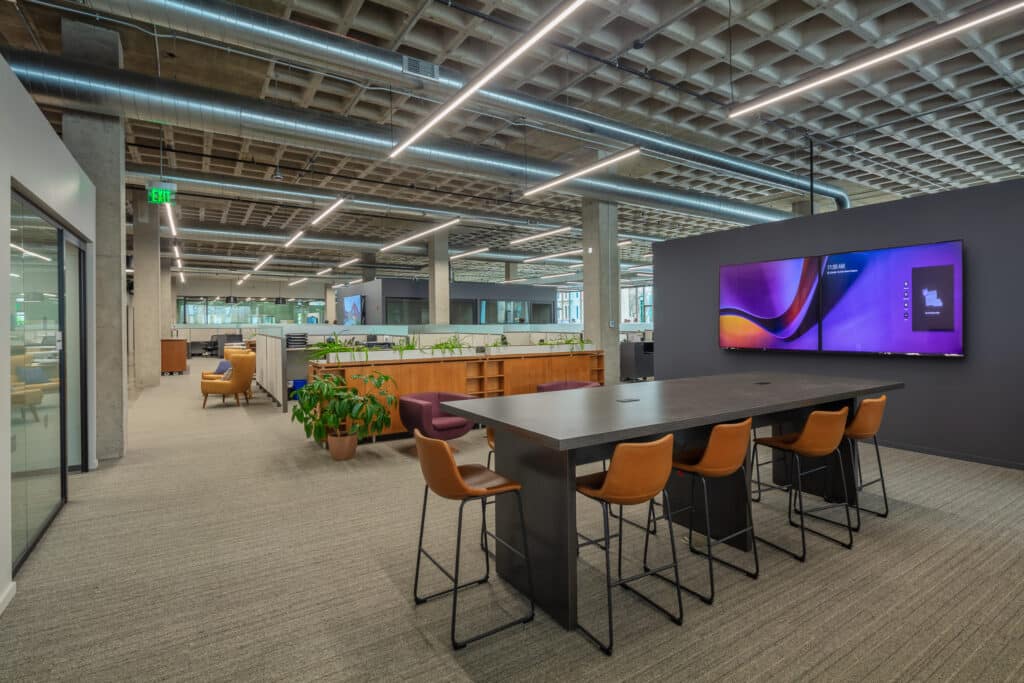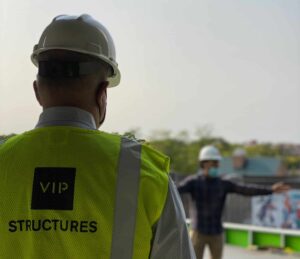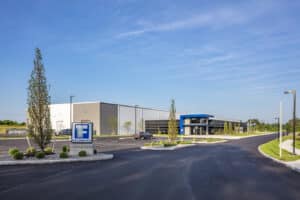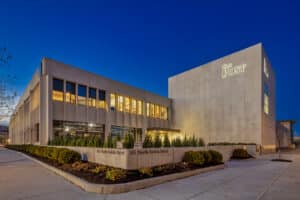VIP Structures’ new office headquarters at the old Post Standard Building in downtown Syracuse. Our space was designed with the well-being of our employees, planet, and community in mind. Features like occupation sensored lights, multi-control HVAC, and dual-flush toilets are small changes that we felt would have a big impact on the planet. Plenty of natural light, maximum air filtration, operable windows, and inviting break spaces create a conducive work environment for our employees.
As more and more owners feel a responsibility to build sustainably, green building design and construction is becoming more of a common practice in mixed-use and commercial construction. Green building goes beyond just installing solar panels or recycling. True green building requires using a whole building approach to provide greener solutions to normal building processes that conserve water, save energy, and provide cleaner indoor air.
In a previous post, we discussed why sustainable design matters and the benefits of green building. Wondering why green building is on the rise? Results from a survey conducted with firms from 62 countries showed that 55% reported that the top reasons for choosing green building stemmed from increased health and productivity benefits.
Five of the green systems that are being utilized in building engineering are radiant floors, gray water recycling, solar power, geothermal systems, and energy efficient window systems. These systems working together can achieve an owner’s energy and water conservation goals while also reducing utility bills. Sustainable building creates a win for the environment, the building owner, and its occupants.
Radiant Floors
Radiant floors are an excellent way to efficiently heat a space with less energy. This can also be done with renewable energy, such as solar, for an even greener method that puts less stress on the grid. Radiant floors can use electrical tubing in concrete floors, which conduct heat that is transmitted to occupants from the ground. They can also contain water tubing that is heated from solar panels that collect solar energy and deliver it to the tubing in the form of heat. This helps occupants to meet their comfort levels more quickly than with traditional heat delivery through air systems where the heat rises to ceilings and is wasted.
Gray Water Recycling
One of the most used natural resources by buildings is water. In fact, buildings and facilities use up to 12% of our water supply. That’s why water conservation is becoming an increasingly important part of conservation efforts, and recycling building gray water is a great way to accomplish it.
What is gray water? Gray water is the water that runs off from condensate from air conditioning units and other equipment that uses water. Oftentimes, this water is disposed with waste water. Unlike waste water, however, gray water can be reused to fuel boilers, hydronic cooling equipment, and even irrigate plants. New sustainable design-build methods are finding ways to maximize resources, including water.
Solar Power
Solar has been a buzz word in building engineering for a while now and for good reason. With the price of solar panels dropping, solar energy is becoming one of the most cost effective, as well as practical ways to install a renewable energy source on a commercial building. Many solar companies also make the process easier by handling installation and taking care of the process of applying for incentives for buildings that qualify for solar rebates. This helps building owners cope with the initial up-front investment.
Solar power installations can easily be mounted on roofs or as freestanding installations on a property where they serve the dual purpose of collecting solar energy and preventing solar gain into the building. Tesla’s solar roofs are also changing how we see solar; and soon solar windows and sidewalks might be viable economical choices for collecting solar energy.
Geothermal Systems
Geothermal systems are one of the best ways to efficiently heat or cool a building with a renewable source. It uses the natural cool temperatures below ground to cool water in pipes and then runs it through chilled water coils, just like a chilled water system. It can also be used for heating by a similar process. The water running in the closed loop absorbs heat from the ground and releases it to a heat pump, which in turn provides warm air to the building. It can also be used to warm radiant floors and for domestic hot water heating.
Energy Efficient Window Systems
Windows are responsible for 25% of the heat gain and loss in a building, typically from heat flow through window panes and around poorly sealed frames. Energy efficient windows provide glazing in the form of double panes and triple panes that are designed to inhibit the flow of heat. These type of windows have two or three panes with argon gas in between that stop heat from leaving or entering a space. This, combined with a tightly sealed frame, help secure the building envelope and prevent heat losses and gains.
Additionally, lighting systems like daylighting take advantage of natural light through the strategic placement of windows and eaves, and provide natural lighting that does not rely on electrical lighting systems. So your building can receive natural light without gaining or losing heat that has to be recuperated by heating and cooling systems.
Building owners are seeing the financial gains from utilizing green building practices, which means that builders can count on them becoming common practice in the future of the architecture, engineering, and construction industries.
A combination of green systems and practices such as radiant floors, gray water systems, solar energy, geothermal, and energy efficient window systems working together are the best way to achieve successful sustainable systems in a building. When these are combined with indoor air quality best practices, a building can see superior comfort levels while sustaining the financial benefits of lowered energy bills.
For more information on VIP Structures or IPD Engineering, contact our company using the form below. Like reading our blog? Subscribe to it by entering your email to the left and be the first to receive new content.
VIP Structures is a
national design-build firm headquartered in Syracuse, NY. VIP has over 45 years
of professional experience in architecture, construction, and development, as
well as in-house engineering and property management expertise for commercial,
industrial, and institutional clients. For more information, visit
www.vipstructures.com.




